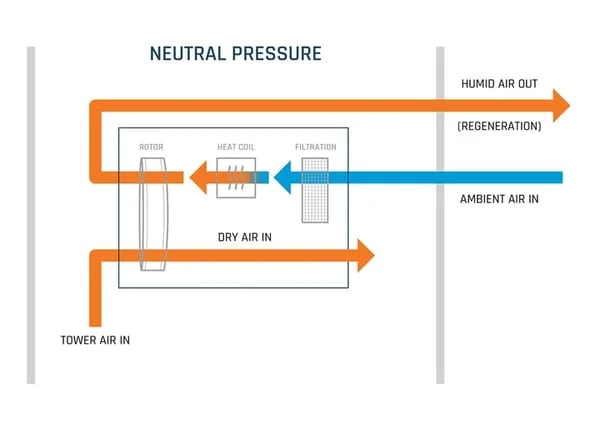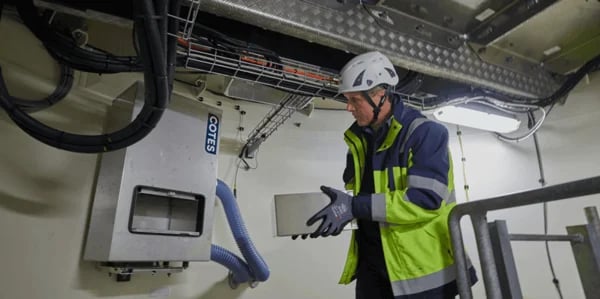In this blog post, we outline the different types of dry-air solutions available and share recommendations from an in-depth investigation for a fleet of offshore turbines in Scandinavia. In this case, we approached this investigation from a retrofit perspective, but it is of course beneficial to think of a dry-air strategy from the very beginning of the wind turbine lifecycle.
In 2017, Cotes was commissioned to investigate and test the air quality inside wind turbines in an operating offshore wind farm in Scandinavia and was asked to recommend the best dry-air strategy. Mould issues had been identified in the towers and it was evident that the current dehumidification solution was not performing to standard. Our team of experts was brought in to consult on the best dry-air solution and did a retrofit of the entire wind farm.
Issues with mould [Electrical faults and corrosion]
.webp?width=406&height=346&name=Mold_Growth-min%20(1).webp) Mould growth inside a turbine should be avoided at all costs, because of the harmful effect it has on the maintenance crew. If mould is identified, a turbine must undergo extensive cleaning – at high expense.
Mould growth inside a turbine should be avoided at all costs, because of the harmful effect it has on the maintenance crew. If mould is identified, a turbine must undergo extensive cleaning – at high expense.
At the same time, mould is a visible indication of damp air conditions inside the tower, which cause corrosion and electrical faults, reducing the service life of electronic components. Therefore, it is important to reduce the humidity to a level where mould growth ceases, so that corrosion and electrical faults can be reduced.
Mould growth occurs when relative humidity is 70% RH or more. Therefore, it is desirable to maintain an environment inside the wind turbine where % RH does not exceed this.
The industry recommendation is to keep humidity below 65% RH to prevent corrosion. However, for offshore environments, because salt is present, it is recommended to keep humidity below 55% RH. Fraunhofer also confirms what Cotes' engineers have known for a long time, that there is a direct correlation between humidity and the technical faults that occur in wind turbines.
Have a closer look at the data from this investigation.
Dry-Air strategy – absorption dehumidification
There’s broad consensus in the industry that adsorption technology is the only suitable method for the dehumidification of wind turbines because as well as being service stable, the technology also works in sub-zero temperatures.
There are three main methods of adsorption dehumidification technology:
- 4-Hole dehumidification (neutral pressure)
- Do nothing and hope for the best [we recommend that you take action]
- Combined desalter and dehumidifier in overpressure system (positive pressure)
Method #1
4-Hole dehumidification
A 4-hole installation is the most common installation in infrastructures like buildings and waterworks. However, in wind turbines, it does not work well:
- 4-hole installations do not have efficient salt filtration causing the installation to break down and risks spreading salt
- 4-hole installations cannot build a positive pressure (or overpressure) inside the tower making it necessary to install a comprehensive channel system to distribute air which is expensive and cumbersome to install. The customer to save money and install this system without the air ducting, so the air was not distributed correctly.
A 4-hole installation looks like this:
In short, a 4-hole setup works with 2 airflows:
- A dry airflow where the dehumidifier sucks air from the tower through the silica gel rotor, after which it is dried and dehumidified again.
- To remove moisture from the rotor again (the regeneration process), air from outside the turbine is sucked into the dehumidifier. Here it is filtered, heated, and sucks the moisture out of the rotor. The moisture is now carried out into the open again (outside the turbine), with a warm and moist airflow.
Conclusion
In general, Cotes advises against this solution because we have seen too many problems with improper protection, dehumidifier breakdowns and the spread of salt through the dehumidifier. The reason is that effective filtration of airborne seawater droplets cannot be caught by the filter. Therefore, salt is passed further into the dehumidifier, and in the worst case is spread further inside the turbine. We are aware of several serious breakdowns based on this.
In addition to the problems of effective salt filtration, the 4-hole installation also suffers from poor air circulation. There’s a high chance it will short-circuit itself, i.e., suck the dry air back into the dehumidifier soon after it has left the dehumidifier. This will create a very dry zone around the dehumidifier, but the process of drying the rest of the space will be based on steam pressure equalization, which is very slow.
NOTE: In the case study the turbines had a non-Cotes 4-hole dehumidification solution installed and all the above problems were present. It requires knowledge and experience of the wind industry and offshore environment to supply equipment for offshore wind turbines. If you do not have it, you risk a lot of hassle and expense wind turbine failures.
Method #2
Do nothing and hope for the best (good luck with that)
Everyone is guilty of wishful thinking from time to time. Whether you are aware of the issues and ignore them or simply have not had this issue brought to your attention, you can always choose not to take any action. However, choosing a no dry-air strategy is not really a strategy and you only increase the risk of health and safety issues because of mould, critical component failure due to corrosion, and expensive electrical faults of critical systems leading to expensive unscheduled downtime and loss in production.
Conclusion
With over 20 years of experience in the wind industry and working with some of the biggest names out there, we have the experience and knowledge to advise against this method. Below is a video from one of the leading experts in the wind industry.
Method #3
COMBINED DESALTER AND DEHUMIDIFIER IN AN OVERPRESSURE SYSTEM
 Cotes has developed and patented a special method that overcomes the problems of creating dry and salt-free air in an offshore wind turbine. In the above image, you can see a CWO26 being installed in a wind turbine, and the airflow looks like this:
Cotes has developed and patented a special method that overcomes the problems of creating dry and salt-free air in an offshore wind turbine. In the above image, you can see a CWO26 being installed in a wind turbine, and the airflow looks like this:
%20copy-min%20(1).webp?width=720&height=514&name=Overpressure%2020211015%20Illustrations%20-%20Flow-Diagrams%20(1)%20copy-min%20(1).webp)
In a Cotes combined desalter and dehumidifier, ambient air is sucked into a mixing chamber where it is blended with dry dehumidified air, which removes the water in the saltwater droplets. This causes the salt to change phase, from dissolved to crystalline which allows the salt to be filtered (measured at a 99.9% filtration rate).
The now saltless air is dehumidified and divided into 3 airflows (see the video below to see how it works):
- An airflow for drying out incoming outdoor air
- An air airflow for regeneration of the silica gel rotor
- An air airflow to blow dry and saltless air into the tower
How does the overpressure system work?
Conclusion
Cotes recommends the overpressure solution for the following reasons [Explore the data]:
- Easy installation with no extra ducting needed in the tower since the overpressure itself moves the air upwards.
- The overpressure reduces the infiltration of moist and salty offshore air.
- The dry and salt-free air provides optimum protection against mould, corrosion, and electrical faults.
- A CWO26 (overpressure system) creates a dry (45-55% RH) and protective (salt-free) atmosphere
Get a Cotes dry-air solution recommendation
To create a sound and robust dehumidification solution in offshore turbines, the climatic conditions at sea must be given serious consideration. Otherwise, mould issues, that are expensive to resolve, are likely to occur. Likewise, condensation leading to corrosion, and electrical failures can be expected.
Could you benefit from consultation about the best dry-air strategy for your wind turbines? Our team of experts is here to help..webp?width=260&height=368&name=20210609%20Productimage%20CWO26%20-%20Steel%20overlay-min%20(1).webp)
